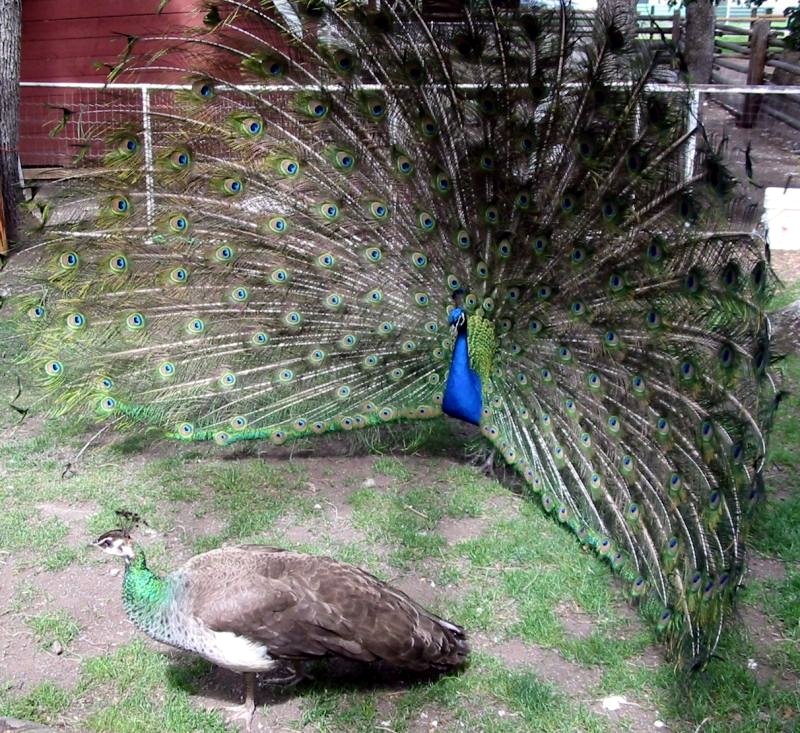Ornamentation is the presence of a decorative structure, or ornament, with no functional purpose in an animal’s physiology/morphology. The use of ornamentation is commonly found in cases of sexual selection, where the ornament is used as a display to attract the attention of mates. The ornaments that appear “the most attractive” to its mates will be the most likely to be chosen as a mating partner. Ornamentation is usually found in the males of species, however they can also be found in the females as well. These ornaments usually have a trade-off in the animal’s survival as they can be metabolically costly to maintain or may increase predation risk.

A popular example of ornamentation seen in peacocks, where their large, colorful, and branching feathers . (http://upload.wikimedia.org/wikipedia/commons/a/a9/Peacock_courting_peahen.jpg)
Harrison & Poe (2012) proposed four possible hypothesis for the existence of varying ornamentations in females. They suggest that female orientation may be driven by either; the genetic correlation hypothesis (in which selection on one sex will lead to a correlated response in the other sex), the social selection hypothesis (in which a hierarchical social standing affects reproductive success, for example males preferring more significant ornaments), selection for species recognition (in which same-species recognition is important), and the sensory drive hypothesis (in which the optimal form of ornamentation is dependent on the environment). They specifically looked at the dewlaps, an ornamental structure on the neck, of the Anolis genus.
The researchers hoped to investigate and analyze the evolution of dewlaps in the female population of the Anolis. They hoped to make comparisons between similar species in order to look for correlations between dewlap characteristics and either physical or environmental traits. The researchers compiled data from various species of Anolis and recorded the sizes of the male and female dewlap relative to body size, also recording the type of environments of some of these species. They created a phylogenetic, or evolutionary, tree of these species and included dewlap size in order to compare across species.

Here are examples of some of the male (top) and female (bottom) dewlaps of various species of Anolis compared in this study. (Harrison & Poe, 2012)
They found a significant correlation between the female dewlap size and the phenotypic difference between the males and females of that species. Small or absent dewlaps in certain species correlated with a wide range of phenotypic differences between the sexes, while large dewlaps correlated with a smaller range of phenotypic difference in males and females. They also found that female dewlap size was significantly influenced by various habitats. Female and male dewlap size were not correlated, and they found no suggestive difference in female dewlap size amongst single or multi-species communities.
Based on their results, the researchers provide support for the sensory drive and social selection hypotheses, that have been previously discussed. The researchers suggested that the significant correlation between female dewlap size and habitat use may convey and support the sensory drive hypotheses, as the anoles have this reproductive need to adapt to the environmental habitats, consisting of several attention-grabbing distractions, in order to command attention. For example the anoles present in largely-dense treetops have been found to have large dewlaps, which the authors suggest may be due to the reproductive need to gather attention from possible mates. However they also suggest that this sensory drive may also be due to the male population density present, specifically regarding the competition to gather the focus/attention of the scarce male individuals. In addition, the researchers suggested that the significant correlation between female dewlap size and general differences between males and females may provide support for the social selection hypothesis. However the researchers also state that this correlation may either portray a sexual selection aspect of pressure on females or it may convey a territorial-based pressure. Based on the lack or a correlation between female dewlap size and male dewlap size/community richness, they concluded that the genetic-correlation and species-recognition hypotheses were not valid in this specific case.
Finally, the researchers suggest that future research should focus on behavioral observations regarding the supported hypotheses and correlations found in their study. They state that future research into this ornamental selection on males and females may further our understanding of varying selection pressures on the similar characteristics of different sexes.
References:
Harrison, A. & Poe, S. (2012) Evolution of an ornament, the dewlap, in females of the lizard genus Anolis. Biological Journal of the Linnean Society. 106, 191-201.
